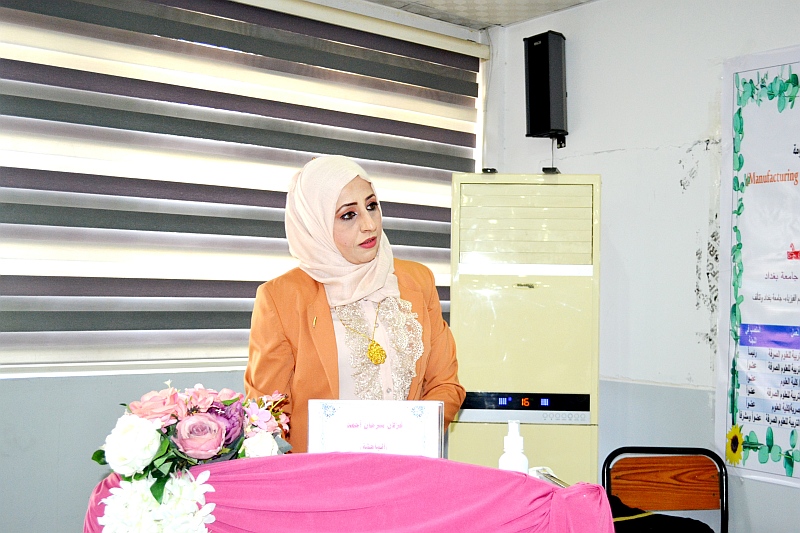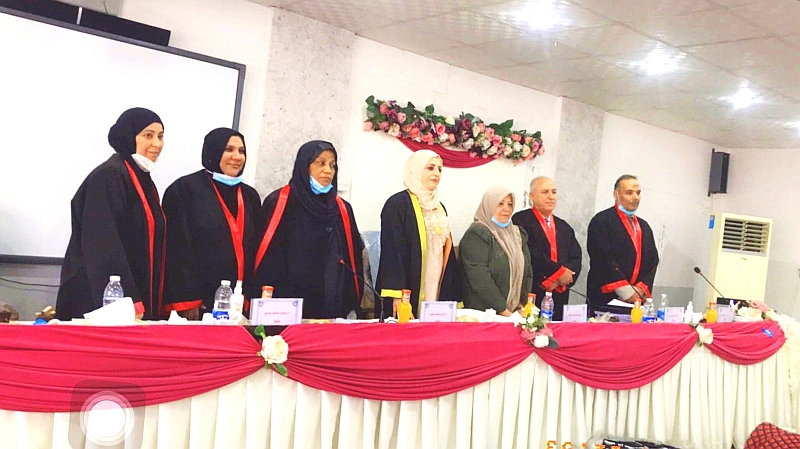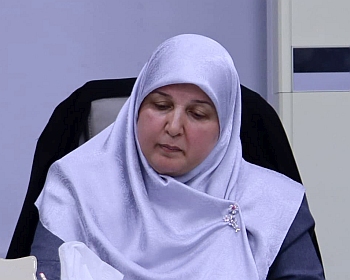ناقش قسم الفيزياء في كلية التربية للعلوم الصرفة ( ابن الهيثم ) اطروحة الدكتوراه الموسومة ( تصنيع ودراسة خصائص ( SnSe )المشوَبه وتطبيقاتها ) للطالبة ( غزلان سرحان أحمد ) التي انجزتها تحت اشراف التدريسية في القسم ( أ.د. بشرى كاظم حسون ) ونوقشت من قبل اعضاء لجنة المناقشة المدرجة اسمائهم فيما يأتي :
-
أ.د. علية عبد المحسن شهاب (رئيسا)
-
أ.د. أيمان حميد خضير (عضوا)
-
أ.د. صلاح قدوري هزاع (عضوا)
-
أ.د. بشرى هاشم حسين (عضوا)
-
أ.م.د. أسامه عبد العزيز داخل (عضوا)
-
أ.د.بشرى كاظم حسون(عضوا ومشرفا)
وتهدف هذه الدراسة الى :
-
تحضير أغشية SnSe من سبيكة فوق اساس زجاجي من خلال آلية التبخير الحراري.
-
دراسة تأثير درجات حرارة التلدين (100،150.200) درجة مئوية وإضافة عناصر (Cu و S) بنسب مختلفة على الخصائص البصرية والتركيبيه والصورية والكهربائية لكل لكل اغشية SnSe .
-
أجهزة الوصلات غير المتجانسة المصنعة من (p-SnSe/n-Si) للتطبيقات الكهروضوئية.
-
دراسة تأثير درجات حرارة التلدين وإضافة العناصر (S,Cu) على أداء جهاز الوصلة غير المتجانسة (p-SnSe/n-Si).
حُضرت في هذا البحث سبيكة المركبSnSe) ) بإذابة عناصر السبيكة في انبوب من الكوارتز مفرغ من الهواء , وضعت الانبوبة في فرن كهربائي بدرجة حرارة 1000ºC)) لمدة خمس ساعات . وبإجراء فحوصات حيود الاشعة السينية لمسحوق السبيكة تبين أنها تمتلك تركيب متعدد التبلور ومن النوع المعيني القائم (Orthorhombic ). كل أغشية (SnSe) النقية والمشوبّة والملّدنه بدرجات حرارة Cº((100,150,200 وبسمك( 400±20 nm ) بمعدل ترسيبnm/sec (3.33±0.1)وبأستعمال تقنية التبخير الحراري في الفراغ أُستعمل النحاس والكبريت كمشوّبات وبنسب تطعيم %(3,5,7). أظهرت نتائج قياسات (XRD)إن جميع الاغشية المحضّرة كانت ذات تركيب متعدد التبلور من النوع المعيني القائم مع هيمنة النمو بالاتجاه ((111 للأغشية المحضرة كافة ,وقد تحسنت الخصائص التركيبية وأزداد التبلور بزيادة درجة حرارة التلدين ونسب التشويب كافة .أُستعمل مجهر القوة الذرية ( (AFMلدراسة طبيعة السطح وإيجاد الحجم الحبيبي وتحديد خشونة السطح تم استعمال تقنية مجهر القوة الذرية (AFM) ,حيث أظهرت النتائج إن جميع الاغشية المحّضرة تمتلك توزيع متجانس للحبيبات وإن الحجم الحبيبي يزداد بزيادة درجة حرارة التلدين وهذا ما يؤكد نتائج.XRD كما يزداد الحجم الحبيبي بزيادة نسبة التشويب للنحاس والكبريت على حدٍ سواء . عند إجراء قياسات الخصائص الكهربائية تبين إن جميع الأغشية المحّضرة لها آليتين للانتقال الالكتروني وبالتالي فأنها تمتلك طاقتي تنشيط , وأظهرت النتائج إن التوصيلية تزداد بزيادة درجة حرارة التلدين وبزيادة نسب التشويب للنحاس والكبريت ,أما نتائج تأثير هول فقد بينت إن الاغشية كافة من نوع P-type وإن تركيز الحاملات يزداد بزيادة درجة حرارة التلدين ونسب التشويب . صُنعّت الخلية من المفرق الهجين Al/p-SnSe/n-Si/Alالنقي والمشّوب بالنحاس والكبريت .وقد بينّت نتائج قياسات (سعة-جهد)إن المفرق المصّنع هو من النوع الحاد ,وان زيادة درجة حرارة التلدين ونسبة التشويب أدت الى زيادة عرض منطقة الاستنزاف وزيادة جهد البناء الداخلي ونقصان سعة المفرق . أظهرت نتائج قياسات (تيار – جهد) زيادة كفاءة الخلية بزيادة درجة حرارة التلدين وبزيادة نسبة التشويب للنحاس والكبريت وكانت اعلى قيمة للكفاءة عند نسبة تشويب (7%S) حيث بلغت 5.2% مقارنة ببقية الخلايا الشمسية المحضرة . أما بقياس الخواص البصرية فقد تبين أن الانتقالات البصرية كانت مباشرة مسموحة وإن قيم الامتصاصية قلت بزيادة درجة حرارة التلدين بينما ازدادت بزيادة نسب التشويب بالنحاس ,من جهة أخرى فقد سلكت الامتصاصية بالكبريت سلوكين حيث ازدادت في المنطقة المرئية عند طول موجي nm(600-400) وقلت عند الاطوال المجية العلى من nm600 ,اما النفاذية تسلك سلوكاً معاكسا للأمتصاصية ,قيم فجوة الطاقة تزداد بزيادة درجة حرارة التلدين وبزيادة نسبة التشويب بالكبريت بينما تقل بزيادة نسبة التشويب بالنحاس ,كما تم حساب الثوابت البصرية الاخرى كمعاملات الامتصاص والانكسار والخمود وثابت العزل الكهربائي بجزأيه الحقيقي والخيالي وعامل الفقد وعامل الجودة كدالة لطاقة الفوتون .
وخلصت الطالبة الى التوصيات الاتية :
-
تحضير أغشية SnSe باستخدام طريقة الترسيب بالليزر النبضي مع نفس درجات حرارة التلدين والمنشطات ودراسة الخواص البصرية والكهربائية والإنشائية ومقارنة النتائج.
-
تصنيع SnSe-cds: Sn وصلة P-N ، ودراسة تأثير استخدام تلامس أومي متنوع على كفاءة التحويل.
-
تصنيع الخلايا الشمسية SnSe باستخدام آلية التبخير الحراري وفحص تأثير السماكة ودرجات حرارة الركيزة والتطعيم مع مواد أخرى مثل (Ag) على خواص الخلايا الشمسية.
Department: Physics
Title of thesis: Manufacturing and characterization study of doped SnSe thin films and their application
Name: Ghuzlan Sarhan Ahmed
Supervisor
Prof.Dr. Prof.Dr. Bushra Kadhem Hassun
Aim of the Study
The major purposes of this work are
* Preparing SnSe films from alloy over glass substrate via the mechanism of thermic evaporating
* Studying annealing temperatures effect (100,150.200) ºC , and adding elements (Cu and S)with different ratio on Optical, Structural , Morphological, as well as Electric characteristics of every SnSe film
* Fabricated hetero-junction devices of (P-SnSe /n-Si) for photovoltaic application
* Studying the influence of annealing temperatures and adding elements
(Cu and S) on performance of (P-SnSe/n-Si) hetero-junction device
Abstract: In this study, the SnSe alloy was prepared by melting its components (that previously mixed in an evacuated quartz tube) at 1000 ºC for five hours using a conventional oven. The X-ray diffraction analysis shows that the resulted alloy’s powder exhibits a polycrystalline orthorhombic structure. All pure and doped SnSe thin films and annealed at (100, 150, and 200) ºC. with (400±20) nm thickness were prepared at a fixed deposition rate of (3.33±0.1) nm/sec using a thermal evaporation technique. Copper (Cu) and sulfur (S) were used as dopants with (3, 5 and 7) % for SnSe films. The XRD results show that the films are polycrystalline with an orthorhombic structure and a preferred orientation a long (111) plane. The structural properties and the degree of crystallinity were improved along with increasing both the annealing temperatures and doping concentration. AFM or what we can call it Atomic force microscopy was utilized for studying the morphology of surfaces and predicting the grain size and the surface roughness. The results show that all the films have homogenous and smooth surfaces with well distributed grains, and increase of the grain size with increasing annealing temperature and doping concentration. The optical measurements show that the films are of the direct allowed transitions. The absorption reduction with increasing annealing temperature, whereas the absorption of Cu-doped SnSe films it increases with increasing Cu concentration in the films. On the other hand, S-doped SnSe films display two different behaviors of absorption. The absorption was increased in the visible region around (400 – 600) nm, while it decreased at longer wavelength higher than 600 nm. The transmittance shows an opposite behavior than the absorption. The optical band gap energy was increased when annealing temperatures and S concentration increasing, while it decreases with increasing Cu concentration. In addition, the quantities of the optical behavior like absorption coefficient, extinction coefficient, refractive index, real and imaginary dielectric constants, loss factor, and quality factor were calculated as a function of photon energy. The electrical properties show that all the films appear two mechanisms of transition indicating that they have two activation energies. The electrical conductivity increased with increasing both annealing temperature and (Cu & S) concentrations. The Hall Effect measurements show the following: Every film was p – type, and concentrating of carriers increases with raising annealing temperatures and dope concentration
Solar cells of refined as well as doped SnSe thin films with Al/p-SnSe /n-Si/Al hetero-junctions were fabricated, and the measurements of (C-V) illustration that they are of abrupt hetero-junctions. Also, the depletion width and the built-in potential raised with raising both the temperature of annealing and doping concentrating. However, the capacitance of hetero-junction reduced with increasing both the temperature of annealing and concentration of dopant. The current- voltage characterization showed increasing the conversion efficiency of the solar cells with increased of annealing temperatures and the concentration of dopant, and the highest value of efficiency of 5.2 % was obtained for (7 %) S-doped SnSe thin film compared to other fabricated solar cells
Future work
-
Preparing SnSe films using pulse laser deposition method with same annealing temperatures and doping and study the optical, electrical, structural properties and comparing the results
-
Fabrication of SnSe-cds:Sn P-N junction solar cell ,and examine the impact of using various ohmic contacts on the conversion efficiency
-
Manufacture SnSe solar cell using thermal evaporation mechanism and examine the thickness effect, substrate temperatures, and doping with other materials such as (Ag) on the properties of solar cell











